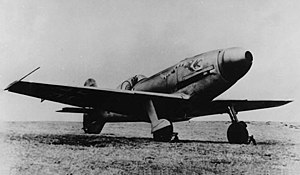Messerschmitt Me 209
| Me 209/Bf 109R | |
|---|---|

| |
| Messerschmitt Me 209 V4 | |
| Role | Propaganda, Technology demonstration/Fighter |
| Manufacturer | Messerschmitt |
| Designer | Willy Messerschmitt |
| First flight | 1 August 1938 |
| Number built | 4 |
The first Messerschmitt Me 209 was a single-engine
The designation Me 209 was given for propaganda purposes to cause confusion with the Messerschmitt Bf 109, the Luftwaffe's primary fighter throughout World War II. It was later reused for the actual proposed successor to the Bf 109.
Design and development
The designation Me 209 was used for two separate projects during World War II. The first was a record-setting, single-engined race aircraft, for which little or no consideration was given to adaptation for combat. The second Me 209 was a proposal for a follow-up to the highly successful Messerschmitt Bf 109 which served as the Luftwaffe's primary fighter throughout World War II.[1]
Designed in 1937, the Me 209 was a completely separate aircraft from the Bf 109, solely designed to break speed records. It shared only its
Testing


The aircraft achieved its purpose when test pilot
The idea of adapting the Me 209 racer to the fighter role gained momentum when, during the Battle of Britain, the Bf 109 failed to gain superiority over the RAF Supermarine Spitfire.[citation needed] The little record-setter, however, was not up to the task of air combat. Its wings were almost completely occupied by the engine's liquid cooling system and therefore prohibited conventional installation of armament. The aircraft also proved difficult to fly and extremely hard to control on the ground. Nevertheless, the Messerschmitt team made several attempts to improve the aircraft's performance by giving it longer wings, a taller vertical stabilizer, and installing two synchronized 7.92 mm (.312 in) MG 17 machine guns in the engine cowling. Its various modifications, however, added so much weight that the Me 209 ended up slower than the contemporary Bf 109E.[4] This first Me 209 project was soon cancelled.
Propaganda use
The Me 209's designation was used by Messerschmitt as a propaganda tool. Although the aircraft was a "single purpose" high-speed experimental prototype, it was hoped that its name would associate it and its world-beating performance with the Bf 109 already in combat service.[3]
In 1939, the speed record achievement of the Me-209 was used for a propaganda disinformation campaign, wherein the aircraft (possibly from its post-July 1938 first flight date) was given the designation Me 109R, with the later prefix, never used for wartime Bf 109 fighters.[8] This disinformation was naturally designed to give an aura of invincibility to the Bf 109, an aura not dispelled until the conclusion of the Battle of Britain.[citation needed]
Surviving aircraft

The fuselage of the Me 209 V1 is currently on display, at the Polish Aviation Museum in Kraków, Poland and was once a part of Hermann Göring's personal collection.
Specifications (Me 209 V1)
Data from Die Deutsche Luftrüstung 1933–1945[9]
General characteristics
- Crew: one
- Length: 7.24 m (23 ft 9 in)
- Wingspan: 7.8 m (25 ft 7 in)
- Height: 3.2 m (10 ft 6 in)
- Powerplant: 1 × Daimler-Benz DB 601ARJinverted V-12 liquid-cooled piston engine, 1,324 kW (1,775 hp)
Performance
- Maximum speed: 755 km/h (469 mph, 408 kn)
See also

Related development
Related lists
Notes
- ^ a b Lepage 2009, p. 220.
- ^ Matthews 2001, p. 45.
- ^ a b Green 1960, p. 160.
- ^ a b Green 1960, p. 161.
- ^ "Conquest I". Archived from the original on 2016-04-02. Retrieved 2015-03-21.
- ^ "Grumman F8F-2, Bearcat, "Conquest I"." Archived 2012-01-20 at the Wayback Machine National Air and Space Museum. Retrieved: 14 July 2011.
- ^ Stüwe 1999, pp. 207, 211–213.
- ^ Wagner and Nowarra 1971, p. 229.
- ^ Nowarra 1993, pp. 215–218.
Bibliography
- Feist, Uwe. The Fighting Me 109. London: Arms and Armour Press, 1993. ISBN 1-85409-209-X.
- Green, William. War Planes of the Second World War, Fighters, vol. I. London: Hanover House, 1960.
- Jackson, Robert. Infamous Aircraft: Dangerous Designs and their Vices. Barnsley, Yorkshire, UK: Pen and Sword Aviation, 2005. ISBN 1-84415-172-7.
- Kulikov, Victor (March 2000). "Des occasions en or pour Staline, ou les avions allemands en URSS" [Golden Opportunities for Stalin, or German Aircraft in the USSR]. Avions: Toute l'Aéronautique et son histoire (in French) (84): 16–23. ISSN 1243-8650.
- Kulikov, Victor (April 2000). "Des occasions en or pour Staline, ou les avions allemands en URSS". Avions: Toute l'Aéronautique et son histoire (in French) (85): 44–49. ISSN 1243-8650.
- Lepage, Jean-Denis G.G. Aircraft of the Luftwaffe, 1935-1945: An Illustrated Guide. Jefferson, North Carolina: McFarland & Company, 2009. ISBN 978-0-7864-3937-9.
- Matthews, Birch Race with the Wind: How Air Racing Advanced Aviation Zenith Imprint, 2001.
- Nowarra, Heinz J. Die Deutsche Luftrüstung 1933–1945: Band 3 Flugzeugtypen Henschel - Messerschmitt (in German). Bonn, Germany: Bernard & Graefe Verlag, 1993. ISBN 3-7637-5467-9.
- Stüwe, Botho. Peenemünde West (in German). Augsburg, Bavaria, Germany: Bechtermünz Verlag, 1999. ISBN 3-8289-0294-4.
- Wagner, Ray and Heinz J. Nowarra. German Combat Planes: A Comprehensive Survey and History of the Development of German Military Aircraft from 1914 to 1945. New York: Doubleday & Company, 1971.
